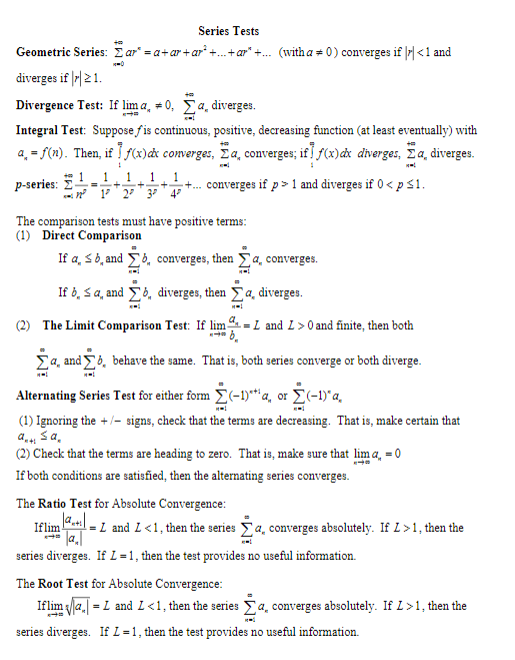
Calculus: Early Transcendentals
8th Edition
ISBN: 9781285741550
Author: James Stewart
Publisher: Cengage Learning
expand_more
expand_more
format_list_bulleted
Question
Hi,
Here's my question:
Determine if the series is absolutely convergent, conditionally convergent, or divergent.
(summation of n=1 and n goes to infinity of) sin(pi(n)/6)/(1+n^(3/2))
This series converges by the Direct Comparison Test (see photo of a list of series tests below), but I need to use another test or two to find if the series is conditionally or absolutely convergent. However, I don't know which one in the list to use. All I know is that I can't use the root test, and it doesn't seem like the
Thanks!

Transcribed Image Text:Series Tests
Geometric Series: Σ ar.-a+ ar + ar' +..tar" + (witha # 0) converges if I < 1 and
vrges f 21
Divergence Test: If lima,#0, Σα.dverges.
Integral Test: Suppose fis continuous, positive, decreasing function (at least eventually) with
4° f(n). Then, if If(x)ax converges, Σα. converges; if I f(x)ax dverges, Σα. diverges.
p-series: Σ +-+-+-+.. converges if p > 1 and diverges if 0 < p 1
The comparison tests must have positive terms
(1) Direct Comparison
b. and Σ>, converges, then Σ a, converges.
If a,
If b, s a, and Σ4, diverges, then Σ a, diverges.
(2) The Limit Comparison Test: If lim
- 1 andan fin, then both
Ya and
b, behave the same. That is, both series converge or both diverge
Alternating Series Test for either form Σ(-1)"'q or Σ(-1)"a,
(1) Ignoring the + signs, check that the terms are decreasing. That is, make certain that
(2) Check that the terms are heading to zero. That is, make sure that lima-o
If both conditions are satisfied, then the alternating series converges.
The Ratio Test for Absolute Convergence
lflimPatil-L and L < 1 , then the series Σ a, converges absolutely. If L > 1 , then the
series diverges. If L = 1 , then the test provides no useful information.
The Root Test for Absolute Convergence
!flim Vla,-L and L < 1 . then the series Σ a, converges absolutely. If L > 1 , then the
series diverges. If L = 1 , then the test provides no useful information.
Expert Solution
This question has been solved!
Explore an expertly crafted, step-by-step solution for a thorough understanding of key concepts.
This is a popular solution
Trending nowThis is a popular solution!
Step by stepSolved in 3 steps with 2 images

Knowledge Booster
Learn more about
Need a deep-dive on the concept behind this application? Look no further. Learn more about this topic, calculus and related others by exploring similar questions and additional content below.Similar questions
- 7. Consider the power series (-1)*+1g" n2 n=1 (a) The series converges when |x| R. Find R. (b) Does the series converge when x = R? What about when x = -R? Explain.arrow_forwardcompare the series (1+x)-3=1-3x+6x2-10x3........ with ex= 1+x +x2/2 +x3/6............ Are they both convergent? How can you prove this?arrow_forwardLook at the attached picture please!arrow_forward
arrow_back_ios
arrow_forward_ios
Recommended textbooks for you
 Calculus: Early TranscendentalsCalculusISBN:9781285741550Author:James StewartPublisher:Cengage Learning
Calculus: Early TranscendentalsCalculusISBN:9781285741550Author:James StewartPublisher:Cengage Learning Thomas' Calculus (14th Edition)CalculusISBN:9780134438986Author:Joel R. Hass, Christopher E. Heil, Maurice D. WeirPublisher:PEARSON
Thomas' Calculus (14th Edition)CalculusISBN:9780134438986Author:Joel R. Hass, Christopher E. Heil, Maurice D. WeirPublisher:PEARSON Calculus: Early Transcendentals (3rd Edition)CalculusISBN:9780134763644Author:William L. Briggs, Lyle Cochran, Bernard Gillett, Eric SchulzPublisher:PEARSON
Calculus: Early Transcendentals (3rd Edition)CalculusISBN:9780134763644Author:William L. Briggs, Lyle Cochran, Bernard Gillett, Eric SchulzPublisher:PEARSON Calculus: Early TranscendentalsCalculusISBN:9781319050740Author:Jon Rogawski, Colin Adams, Robert FranzosaPublisher:W. H. Freeman
Calculus: Early TranscendentalsCalculusISBN:9781319050740Author:Jon Rogawski, Colin Adams, Robert FranzosaPublisher:W. H. Freeman
 Calculus: Early Transcendental FunctionsCalculusISBN:9781337552516Author:Ron Larson, Bruce H. EdwardsPublisher:Cengage Learning
Calculus: Early Transcendental FunctionsCalculusISBN:9781337552516Author:Ron Larson, Bruce H. EdwardsPublisher:Cengage Learning

Calculus: Early Transcendentals
Calculus
ISBN:9781285741550
Author:James Stewart
Publisher:Cengage Learning

Thomas' Calculus (14th Edition)
Calculus
ISBN:9780134438986
Author:Joel R. Hass, Christopher E. Heil, Maurice D. Weir
Publisher:PEARSON

Calculus: Early Transcendentals (3rd Edition)
Calculus
ISBN:9780134763644
Author:William L. Briggs, Lyle Cochran, Bernard Gillett, Eric Schulz
Publisher:PEARSON

Calculus: Early Transcendentals
Calculus
ISBN:9781319050740
Author:Jon Rogawski, Colin Adams, Robert Franzosa
Publisher:W. H. Freeman


Calculus: Early Transcendental Functions
Calculus
ISBN:9781337552516
Author:Ron Larson, Bruce H. Edwards
Publisher:Cengage Learning